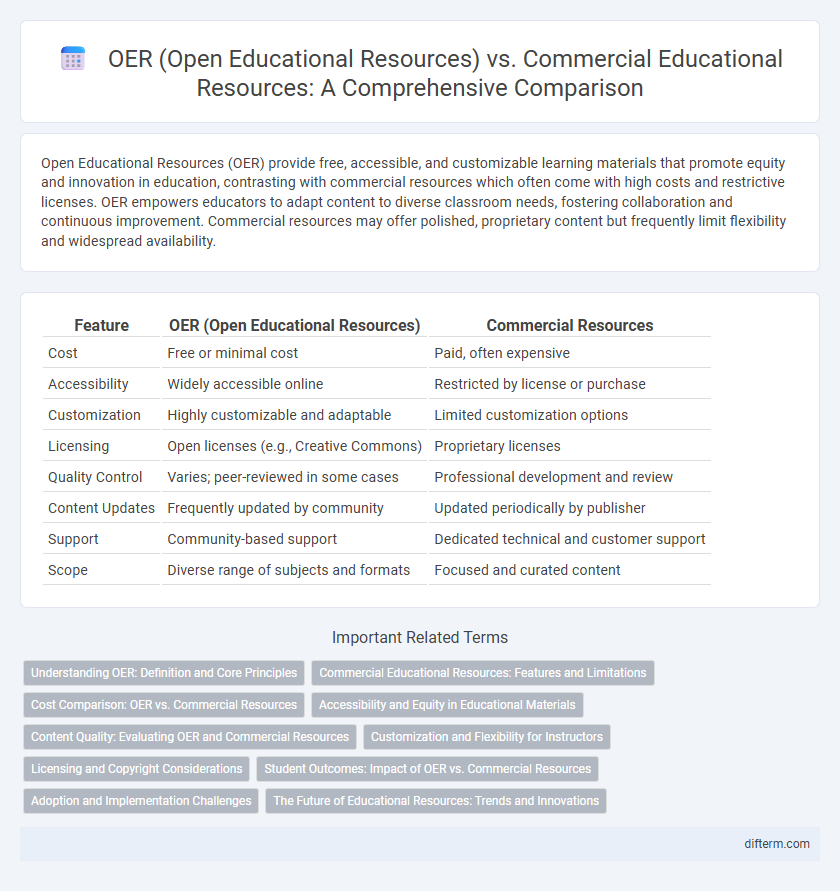Open Educational Resources (OER) provide free, accessible, and customizable learning materials that promote equity and innovation in education, contrasting with commercial resources which often come with high costs and restrictive licenses. OER empowers educators to adapt content to diverse classroom needs, fostering collaboration and continuous improvement. Commercial resources may offer polished, proprietary content but frequently limit flexibility and widespread availability.
Table of Comparison
| Feature | OER (Open Educational Resources) | Commercial Resources |
|---|---|---|
| Cost | Free or minimal cost | Paid, often expensive |
| Accessibility | Widely accessible online | Restricted by license or purchase |
| Customization | Highly customizable and adaptable | Limited customization options |
| Licensing | Open licenses (e.g., Creative Commons) | Proprietary licenses |
| Quality Control | Varies; peer-reviewed in some cases | Professional development and review |
| Content Updates | Frequently updated by community | Updated periodically by publisher |
| Support | Community-based support | Dedicated technical and customer support |
| Scope | Diverse range of subjects and formats | Focused and curated content |
Understanding OER: Definition and Core Principles
Open Educational Resources (OER) are freely accessible, openly licensed materials that support teaching, learning, and research, enabling users to retain, reuse, revise, remix, and redistribute content. Unlike commercial resources, OER prioritize inclusivity, affordability, and adaptability, promoting equitable access to high-quality educational materials worldwide. Understanding OER's core principles involves recognizing their commitment to openness, collaboration, and continuous improvement in educational practices.
Commercial Educational Resources: Features and Limitations
Commercial educational resources offer professionally developed content with structured curricula, multimedia elements, and comprehensive support services, often backed by established publishers. These resources provide consistent quality and alignment with standardized testing but come with high costs, limited adaptability, and restricted access due to licensing agreements. Users may face challenges in customization and flexibility, hindering the ability to tailor materials to specific learner needs or emerging educational trends.
Cost Comparison: OER vs. Commercial Resources
OER (Open Educational Resources) offer significant cost savings compared to commercial educational materials, often available for free or at minimal cost, reducing financial barriers for students and institutions. Commercial resources typically involve high upfront costs, including licensing fees and expensive textbook purchases, which can strain educational budgets. The adoption of OER enables schools to allocate funds toward enhancing educational quality and access while maintaining comprehensive, up-to-date content.
Accessibility and Equity in Educational Materials
Open Educational Resources (OER) significantly enhance accessibility by providing free, adaptable, and widely available learning materials, reducing financial barriers for diverse student populations. Commercial educational resources often come with high costs and restrictive licensing, limiting equitable access and customization for varied learning needs. Emphasizing OER in education promotes inclusivity and supports equitable opportunities by ensuring all students can access quality materials regardless of socioeconomic status.
Content Quality: Evaluating OER and Commercial Resources
Evaluating content quality in Open Educational Resources (OER) versus commercial resources reveals distinct differences in accessibility, adaptability, and peer review processes. OER often undergo collaborative content creation and continuous updates by educators, resulting in diverse perspectives and readily customizable materials, whereas commercial resources typically follow rigorous editorial standards with dedicated quality control teams ensuring consistency and accuracy. Studies indicate that while commercial resources excel in polished presentation and standardized assessments, OER provide comparable pedagogical effectiveness and increased relevance through localized adaptations.
Customization and Flexibility for Instructors
Open Educational Resources (OER) offer unparalleled customization and flexibility, allowing instructors to adapt and modify content to meet specific course objectives and student needs. Unlike commercial resources, which often come with restrictive licensing and fixed formats, OER enables educators to remix, update, and personalize teaching materials freely. This adaptability supports diverse teaching styles and fosters innovative pedagogical approaches that enhance learning outcomes.
Licensing and Copyright Considerations
OER (Open Educational Resources) provide flexible licensing through Creative Commons, enabling free use, adaptation, and redistribution while ensuring proper attribution. In contrast, commercial resources often come with restrictive copyright licenses that limit sharing and modification, requiring users to purchase access or pay royalties. Understanding these licensing and copyright differences is crucial for educators to legally customize content for diverse learning environments.
Student Outcomes: Impact of OER vs. Commercial Resources
Open Educational Resources (OER) significantly improve student outcomes by increasing access to diverse, up-to-date materials without financial barriers, leading to higher course completion rates and improved grades. Studies reveal that students using OER save on textbook costs, resulting in reduced dropout rates and enhanced engagement. In contrast, commercial resources often limit accessibility due to high costs, which can negatively affect students' academic performance and equity in education.
Adoption and Implementation Challenges
Open Educational Resources (OER) face adoption challenges including inconsistent quality, limited awareness among educators, and lack of institutional support compared to commercial resources with established reputations and dedicated customer service. Implementation barriers often involve insufficient infrastructure for digital access, complexity in aligning OER with standardized curricula, and the need for professional development to effectively integrate OER into teaching practices. Despite cost advantages, resistance to change and concerns about relevance and updating of content impede widespread adoption of OER in educational institutions.
The Future of Educational Resources: Trends and Innovations
Open Educational Resources (OER) are transforming the education landscape by providing freely accessible, adaptable, and customizable learning materials that foster inclusivity and lifelong learning. Emerging trends emphasize the integration of AI-driven personalized learning tools within OER platforms, enhancing student engagement and outcome measurement compared to traditional commercial resources. Innovations such as blockchain for credentialing and collaborative content creation are positioning OER to surpass commercial educational products in flexibility, scalability, and cost-effectiveness.
OER (Open Educational Resources) vs commercial resources Infographic

 difterm.com
difterm.com